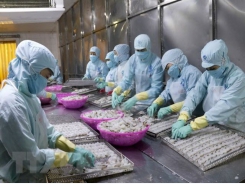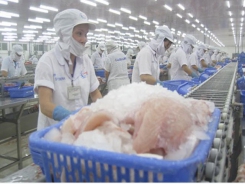Catfish exporters need to diversify

Ho Chi Minh City – Việt Nam’s catfish exports have been robust this year but the country’s overwhelming dependence on the increasingly competitive Chinese market remains a matter of risk.
Catfish exports this year grew by 48 per cent. – Photo cafef.vn
In the first half of the year catfish exports increased by 21 per cent year-on-year to US$1 billion, with China accounting for a full one fourth.
“There is no other fish that can replace catfish in China right now despite the fact that China is the biggest producer of tilapia in the world,” Ong Hàng Văn, deputy general director of the Trường Giang Seafood Joint Stock Company in the Mekong Delta province of Đồng Tháp was quoted as saying by Thời Báo Kinh Doanh (Business Times) newspaper.
“Catfish and tilapia have the same price, but Chinese don’t like tilapia. That is why Vietnamese catfish exports to the market have increased significantly.”
Exports this year grew by 48 per cent.
From July China has cut import tariffs by 2-10 per cent on 221 kinds of seafood products from WTO members including Việt Nam.
The import tax on catfish fillet has been cut from 10 per cent to 7 per cent and on fresh or frozen catfish from 12 per cent to 7 per cent.
This year catfish production in the Mekong Delta has risen by 9.9 per cent to 643,600 tonnes, and it is expected to increase more rapidly because of the huge demand in the Chinese market.
More challenges
Other catfish exporters around the world are also targeting the huge Chinese market.
“This is what many Vietnamese exporters are worried about since the Chinese market has become more and more competitive in terms of quality and food safety requirements,” Văn said.
The Việt Nam Association of Seafood Exporters and Producers (VASEP) recently warned its members to ensure the catfish they export to China is of top quality and meets all food safety standards.
“This will help enterprises minimise the impacts on catfish exports to the Chinese market in the time ahead,” a VASEP official said.
VASEP has also urged the Ministries of Agriculture and Rural Development and Industry and Trade to tighten control over the quality of catfish exported.
Vietnamese exports face a challenge since most processing plants are only half automated.
“To compete better, these plants should be fully automatic to reduce production costs and ensure quality and food safety,” the official added.
Seafood experts have warned that growing catfish exports based on Chinese demand is risky.
“Catfish exports face great challenges in the US with its anti-dumping tax, and only three Vietnamese enterprises are able to export to the market,” the official added.
Increasing protectionism in the European Union has caused Vietnamese catfish exports to the market to decrease significantly.
Besides, the Euro’s depreciation against the dollar has caused Vietnamese catfish, priced in the greenback, to become less competitive against European fish.
“Việt Nam catfish should be exported around the world and not depend on one market,” the VASEP official added.
Có thể bạn quan tâm
Phần mềm

Phối trộn thức ăn chăn nuôi

Pha dung dịch thủy canh

Định mức cho tôm ăn

Phối trộn phân bón NPK

Xác định tỷ lệ tôm sống

Chuyển đổi đơn vị phân bón

Xác định công suất sục khí

Chuyển đổi đơn vị tôm

Tính diện tích nhà kính

Tính thể tích ao hồ



 To build a safe raw material area towards…
To build a safe raw material area towards…  Tra fish exporters ordered to monitor quality of…
Tra fish exporters ordered to monitor quality of…